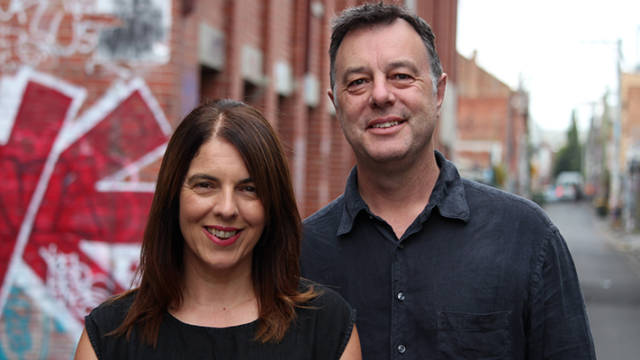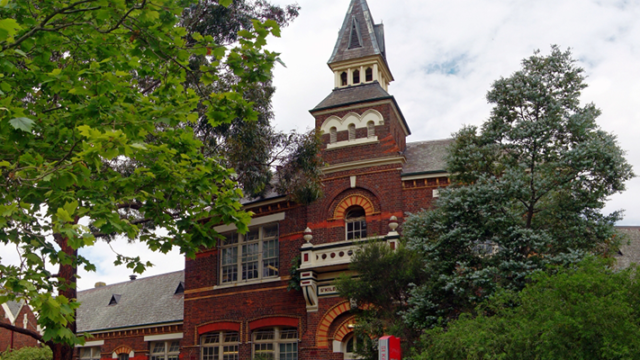Peter and Janine Bring Actors Back to School
ACTF
8 Mar 2018
Want to know a little more about the people behind the big, yellow smiley? In the ACTF’s meet the team series, we introduce our friendly staff and go behind the scenes to discover what makes us tick.
In this Q&A with the ACTF’s Head of Education, Peter Maggs and Curriculum Officer, Janine Kelly, we learn how the ACTF Education team connect schools with the stars.
Tell us about your roles at the ACTF and what ACTF Education offers for teachers.
P: I head the Education area at the ACTF. My role is to develop value-add education components that complement our television series. I facilitate the creation of resources, events and access to expertise that teachers can access to get the most educational value out of our series.
J: My role at the ACTF is Curriculum Officer. One of the main functions of my job is to create education resources mapped to the Australian Curriculum. As a team, we also provide virtual learning via student webinars, online workshops and professional learning for teachers. Through our virtual learning opportunities, we connect students Australia-wide with industry professionals. Many of these students live in rural and remote areas, with limited access to the screen industry.
We also undertake outreach to teachers, schools, subject associations and education departments, alerting them to our new content and learning opportunities for schools.
You both have a background in teaching. Do you find that your background helps you to connect with educators and the way in which they use and access content and technology?
J: My background is in primary education, which is really helpful in my role at the ACTF. For example, I’ve recently been working on the upcoming Lah Lah’s Adventures: Music for Everyone resource, which is aimed at P-2 generalist teachers. Because I’m aware of the time constraints that generalist teachers face, I’m trying to keep the lessons brief and linked to other curriculum areas, to help teachers fit music education into their crowded schedules. We also keep this issue in mind when we plan our virtual learning events for students.
P: My background is in secondary education. My experience is in teaching, working for Education Departments and consulting for digital learning. These roles have required me to understand how teachers are accessing and curating quality content. When we look at developing resources or events for teachers, I’m conscious of how the content must fit in in a way that is relevant and in a form that is accessible.
Like Janine, I also have an appreciation of the time constraints that teachers face, and I understand that teachers can be bombarded with information and content, which can then become difficult to easily assess quality material within the range of information provided. Increasingly, teachers are looking for short-form content that’s relevant, so I think my experience means I’ll be able to put myself in the shoes of the classroom teacher to consider what would be most useful to an educator in a modern, digital classroom.
Which year levels are your resources usually pitched to?
J: Much of our content is well-suited to upper primary and lower secondary students. We do have content pitched at an older audience, such as Australian Rules and Yolngu Boy, and the upcoming Lah Lah Adventures: Music for Everyone resource is targeted at P-2 students.

Alongside your national contact with schools, one-on-one relationship building with teachers is an important part of what you do. Why are these types of relationships also important to you?
P: It’s crucial that we have contact with practising classroom teachers to get qualitative feedback on how educators actively use our resources. While we theoretically service every school in the country, hearing individual classroom stories of teachers and their students using our resources provides us with information that allows us to constantly improve and understand opportunities and challenges teachers may have. Hearing stories from schools is really powerful, as it allows us to know that what we are providing is relevant and valued by teachers. It’s those direct stories that are key.
J: The relationships that we build with teachers, and how we hear about our content being used in real life classrooms guides us in the materials that we create and the virtual learning opportunities that we provide. It also builds trust and credibility if our work is informed by currently practicing teachers.
You regularly run online cast Q&A webinars to provide teachers and students direct access to the behind the scenes of productions and industry professionals. You must see a lot of students excited to meet the stars.
P: We do. Our organisation is in a very privileged position to be able to provide a unique level of access for kids to meet the people behind the series they watch on TV. By connecting Australian classrooms directly with the producer of Dance Academy, a former child actor from Round the Twist and the cast of Little Lunch, kids can experience the opportunity to seek advice on how to get into acting, pursue a love for writing or learn more about the scriptwriting process. There’s no doubt that the kids are really engaged, and they seem to appreciate being able to talk to the people behind the programs they love.
J: In our Little Lunch Cast Q&A Webinar, a girl from the remote town of Dunsborough in Western Australia asked a question. She asked the young actors whether she would be able to pursue a career in acting despite living somewhere so small and remote, and without the same access to opportunities that kids in big cities had. She was concerned that these factors would work against her in achieving her dream.
The cast had such great responses for her, including suggestions to film test shoots from home, and to read and view widely, in order to build her acting skills in creative ways. It was really powerful to have a group of kids giving really great, practical advice to another child from a different part of Australia.
We later heard that this girl had gone on to audition for a part in her school musical, and got the part. She was motivated and inspired by what these young actors could tell her. It’s these kinds of things that can happen through virtual delivery.
What’s the greatest takeaway you find teachers receive from participating in these webinars?
J: In addition to providing teachers and students with access to industry professionals, these virtual learning events allow teachers to tick off various areas of the curriculum. By engaging with others in a digital space, kids are learning about etiquette for online communication, developing literacy skills, and their Media Arts understandings.
P: Virtual delivery means that everyone has access to the same people. It’s really important to us that rural and regional schools can participate in these events. I think the fact that we can have students in remote parts of the Northern Territory, Western Australia, or Queensland asking intelligent, thoughtful questions to directors and scriptwriters and actors, and receiving a personal response, is incredibly powerful. It means that these schools are getting the same level of access as city schools.
Are you seeing changes in the way teachers access content, and how do you go about tailoring resources to changing demand?
P: There’s been a major transformation in the way teachers access content, particularly online. With such an increase in the volume of materials and events out there, it’s important for us to curate relevant content for teachers. It’s about making sure that in a crowded digital space, you can give teachers relevant, bite-sized and easily accessible content that is relevant to the year level, theme and topic that they are teaching.
J: Short-form content is really important to time-poor teachers. We want to spend time on behalf of the teachers in the resource development stage to find the most pertinent examples of the themes we are illustrating. We know it’s important to have curriculum-mapped materials that are relevant and engaging for both teachers and students.
You deliver education resources in a number of ways, including interactive apps, study guides and webinars. What mode of delivery do you see as being the way forward for the future?
J: I think there’s benefit in digital tools like our MY:24 App and Little Lunch App, as they offer high levels of engagement for students. Students use these technologies outside of school in their day-to-day life, and bringing it in to the classroom is developing skills that they already have. Virtual delivery can help to develop skills in Media Arts and Digital Technologies, while study guides encourage reading, writing and speaking skills.
I think each mode of delivery has its benefits. For example, for many of our series, we create education packages, which may include a combination of all three modes of delivery. This allows teachers the freedom to choose which blend of resources will work best for their classroom.
P: When we develop a resource for a television series, we assess which format best suits the given content. Both the MY:24 and Little Lunch series were about storytelling, so in these cases apps were relevant to explore this theme. For these resources, we also develop guides, curriculum resources and instructional videos to assist teachers. We look at each series on a case-by-case basis, and then determine what is relevant for classroom teachers. What is most important to us is ensuring that we provide content which adds value to what students are learning.
If teachers or students would like more information about the kind of education resources and opportunities you provide, how can they reach you?
J: Every year, we do teacher outreach at conferences around Australia. You can chat with us in person at the ALEA National conference in Perth in July. You can also follow our social media pages for updates on resources (Facebook, Twitter and Instagram), stay up to date on our news by subscribing to our eNews and LinkedIn page, and watch our education webinars and support materials on our YouTube channel.
P: We’re always delighted to hear from teachers with any feedback. You can also reach us at education@actf.com.au.





Comments
Comments for this post are open.